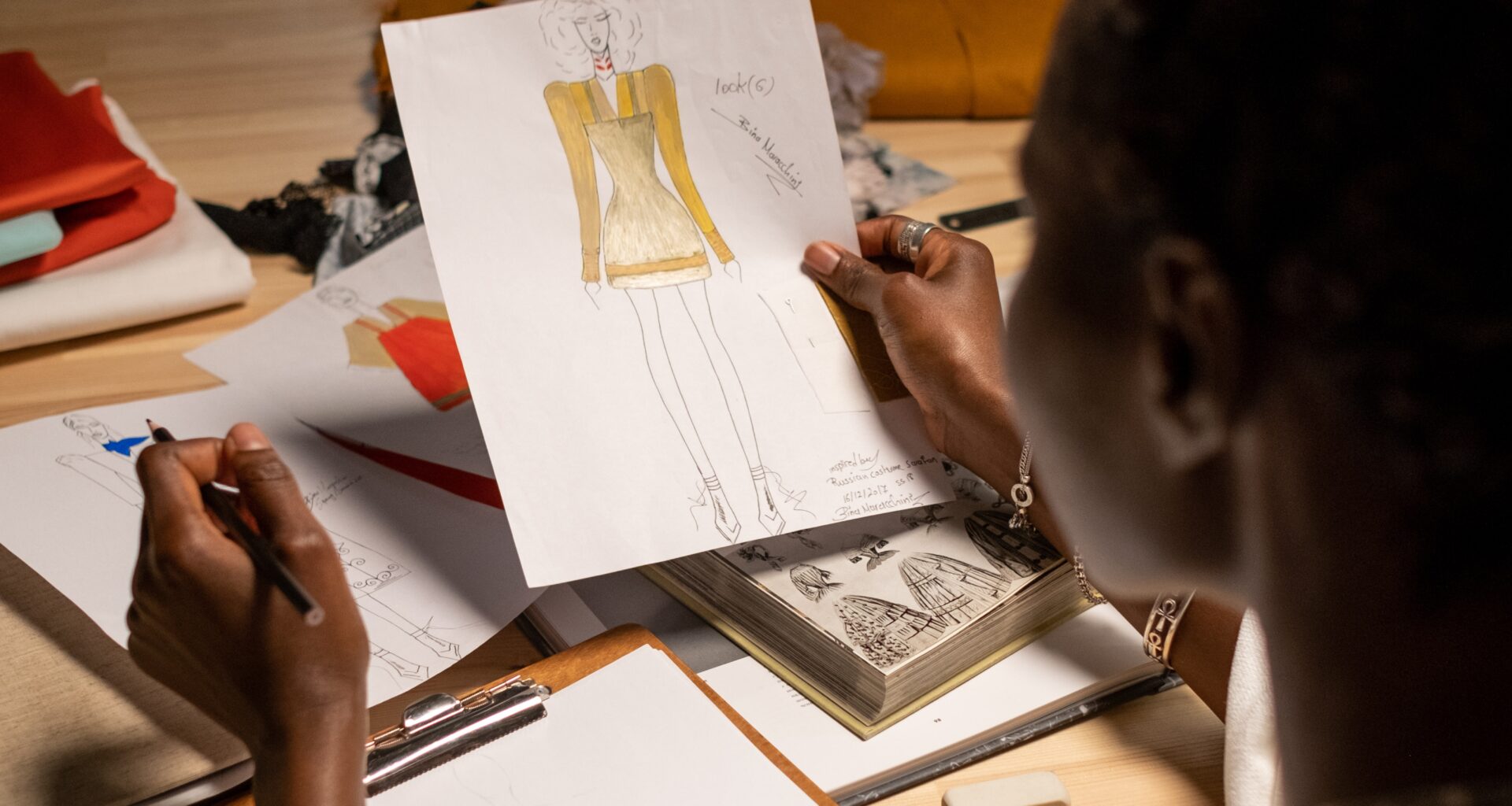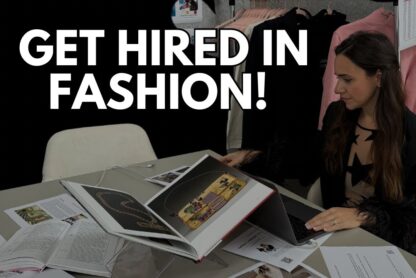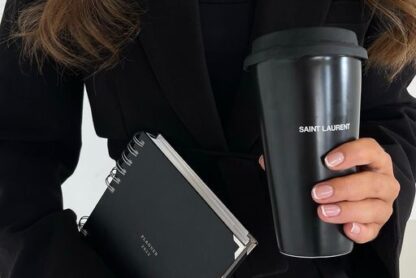How many times have you thought how sad it is to get judged by recruiters based on what you wrote on your resume and cover letter without having the chance to show that you can do the job?
One of the reasons why so many people cannot find a job in fashion is not their lack of experience and no fashion diploma, but their application tools. The old-fashioned application strategies do not work. Nowadays, in order to stand out among a giant pool of applicants, most of whom send a standard CV and sometimes a cover letter, you need unconventional strategies.
While it’s necessary to write down your skills, experiences, and education on your CV and cover letter if you are looking for a job or internship in fashion, I always say that showing is better than telling. So there is something else that you can add to enhance your job application, that will have a more visual impact and give you more chances to be remembered and stand out among the other candidates: a fashion portfolio.
A portfolio gives you the chance to demonstrate your skills and talents to recruiters through a collection of your projects, and get you job opportunities based on your skills, regardless of what you studied or if you have previous experience.
In this article, you are about to break all the myths you may have had about building a portfolio for the fashion industry, such as:
A portfolio is only requested for creative roles
You have nothing to include inside without any previous experience
It’s not useful at the early stages of your career in fashion
Building a portfolio is hard
Etc.
So hang on with me, as by the end of this article, you will learn what’s a portfolio and why YOU need it to work in fashion + a bonus tip: HOW to build a portfolio.
Why You Need A Portfolio To Get A Job In Fashion Quicker
What is a fashion portfolio?
Many identify the fashion portfolio as a collection of sketches and designs. This is a very partial definition of what a portfolio is, as it limits it to the role of a fashion designer only. I, however, believe a portfolio has more potential, and it is a strong document that any fashion professional can build.
In fact, I prefer to define the fashion portfolio as a collection of your projects: works that you did in school, for a contest, as a freelancer…but even just things you did for fun for your personal projects, as a hobby, or just for the sake of building a portfolio.
What roles need a portfolio?
So, we learned that a portfolio is not reserved for designers. What other roles in fashion need a portfolio?
A portfolio is useful for anyone who wants to work in fashion. For some roles, it’s something fundamental when applying for fashion jobs, so let’s start with those.
If you are thinking of pursuing one of the careers below, then a portfolio is a must to have and send:
- Designer
- Stylist
- Fashion writer/journalist
- Social media manager
- Fashion illustrator
- Graphic designer
- Photographer
- Art director
If you want to become a fashion writer, for example, recruiters expect to receive your fashion portfolio with some of your sample articles (no, you don’t need to have had them published in Vogue 😉 ) They will look at it even more than your CV, especially if you are at the beginning of your career.
However, as I said, there are no limitations to roles that can benefit from a portfolio. Creating a portfolio can also be useful, though it’s not mandatory, even for careers on the business side of the industry, such as:
You might think that for analytical and number-oriented roles like buying and merchandising, you cannot show your skills in a portfolio, but that’s not true. A recruiter can, for example, get a glimpse into how confident you are with Excel by analyzing a product assortment’s sell-through, or by a report/analysis you drafted.
For other careers that mix strategies and creativity, recruiters can also evaluate your different skills. So you can show that you know how to create a campaign for a job in communication, a competitor analysis for marketing, a press release, or a database of celebrities and editors for PR, or be even more creative and build a project for a fashion show if you want to work in PR/Event production.
As you can see, anyone can create a portfolio. And in the competitive fashion industry, I have to say that anyone should create a portfolio no matter the career in fashion you are pursuing, and I am going to tell you why.
Why do I need a fashion portfolio?
As I said at the beginning of this article, a fashion portfolio is one of the best unconventional strategies to get a job in fashion. Therefore, while it’s not required for every role, I strongly recommend sending it even for the roles where it’s not mandatory OR even if a job offer for an internship in the creative department doesn’t explicitly mention that you must send a portfolio.
Forget about the fact that it’s not mandatory. If it’s not mentioned in the job description, it doesn’t mean it’s irrelevant. The fact that you are submitting your portfolio is seen by companies as a sign that you care A LOT about that position and that you are making an extra effort to produce this document.
They will appreciate the initiative, time, and effort you spent creating it, especially if you are at the beginning of your career in fashion and you don’t have any experience.
A portfolio can help you land your first internship in fashion
A fashion portfolio is useful at any stage of your career: when looking for freelance jobs, searching for new clients, and in senior positions. But it can also be a game-changer to get your first internship. If you are reading this article, you are probably at the beginning of your career and looking for your first job in fashion, so I think you can relate.
The older you get, the more experience you’ll have, and the more projects you can add to your portfolio. But this doesn’t mean that you can’t build it if you are just starting out.
Sounds strange, doesn’t it? Because you probably always thought of a portfolio as a collection of your works from previous jobs.
If you are still studying or you have just graduated and you have zero or very little experience, you can fill in your fashion portfolio with ad hoc projects that you invented just to build up this document and have something to show to companies.
Think of the portfolio as a visual representation of your job or the job you want to get. When in doubt about what kind of information to include, just think about what the role is about and build projects that are relevant.
For example, if you are an aspiring fashion writer, you can write a couple of articles just to add them to your portfolio even if those articles have never been published anywhere. If you dream of becoming a stylist, you don’t need to wait to be able to style models and celebrities to show your styling skills; you can gather your friends and style outfits on them!
You don’t necessarily need real work experience to demonstrate your skills. You can be super talented even if you are at the beginning of your career. What makes a successful fashion portfolio in fact is not determined by whether the projects are “real” (made for a brand in your previous job) but its content, the quality, and the work itself.
Brands don’t care if your sketches are not from a real work experience or if your photos have not been used for a real fashion campaign. They will focus on the final output: the image, the article, the sketches, your mood board, etc. They will judge your work itself – not where it comes from.
A portfolio serves to showcase your skills
As I said in the beginning, a portfolio is a great tool to show brands directly what you are capable of doing. Inside your CV, you list all of your skills, but it’s with the portfolio that they come to life.
It goes without saying that showcasing your skills is way more effective than just mentioning them. Anyone can say they are a brilliant photographer, stylist, designer, or writer. But if you really want to convince a recruiter or brand, then show them what you can do.
By demonstrating your skills with a portfolio, recruiters don’t have to ask whether or not you have the creativity or talent you are bragging about on your resume; if you send a portfolio, it will be obvious that you actually know your stuff.
A portfolio adds some visuals to your application
Fashion is a creative industry and its main expression is through visuals, no matter the department LINK of the company. So why don’t you communicate yourself in a similar, visual language?
Every role creates something, whether it’s a sketch, an article, a graphic, or a presentation. It doesn’t matter whether you want to work in the creative or business department of a fashion company; the recruiter will appreciate seeing your creativity.
A CV and a cover letter are great but they have lots of text and no images. A portfolio, on the contrary, adds a visual component to your application, and visuals have the power to attract attention – especially in fashion. This is exactly what you want to do when applying for a job in this industry – attract attention – so that you can stand out among other applicants and the recruiter is interested in learning more about you and invite you for a job interview.
How to build your fashion portfolio?
The easiest and fastest fashion portfolio to build is a digital one.
So you can easily share it via links or as a PDF to anyone. You can even build your own fashion website to use as a portfolio or an Instagram profile.
It doesn’t have to be anything too long. 4-5 pages of your best-selected works are enough! If you have more projects only send those that are super relevant for the specific brand.
This could mean that you’ll need different versions of your portfolio. Just like I suggest with your CV, the portfolio should also be as customized to the brand as possible. You can even add one page just dedicated to the specific brand, that you can later change according to the job and company you apply for.
So, are you going to start building/updating your portfolio today?
Remember, even if you have never worked before, there are some projects you can work on from home to build up your first portfolio and send it to companies to boost your chances of getting a job in fashion, especially if you don’t have experience or if you studied something unrelated and you want to demonstrate you know your stuff.
If you need help and guidance on what projects you can add to your portfolio, in my online course Break into the fashion industry, I explain how to build your fashion portfolio step-by-step, with more concrete examples of works you can include for every role, and how to organize the content page by page to build an aesthetic and comprehensive portfolio.









Woaw, this article is so motivated ! I want to build my own now 🙂
What do you think about an Instagram Portfolio more precisely?
What to include in portfolio if you have zero experience and just starting out for fashion stylist role?